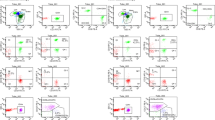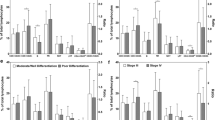Abstract
Immunotherapy plays an important role in cancer treatment. Biomarkers that can predict response, including tumor-infiltrating lymphocytes (TILs), are in the spotlight of many studies. This cohort study was designed to evaluate the role of CD4+ and CD8+ TILs as predictive factors for response to anti PD-1 treatment in patients with metastatic non-small cell lung cancer (NSCLC) or metastatic melanoma. We evaluated the expression of CD4+ and CD8+ TILs in tissue samples of 56 patients with metastatic NSCLC or melanoma treated with anti-PD1 immunotherapy. The study included 30 patients with melanoma and 26 with NSCLC. An association was found between CD8+/CD4+ TILs ratio and response to anti-PD1 treatment in both cancers. Regarding melanoma patients, ratios of CD8+/CD4+ lower than 2 predicted lack of response to treatment (0%) (p = 0.006), while CD8+/CD4+ ratios higher than 2.7 had an 81.3% response rate (p = 0.0001). In addition, we found that the presence of more than 1900/mm2 of CD8+ lymphocytes in the melanoma tumor predicted a 90% response to therapy. In the metastatic NSCLC group, tumors with CD8+ lymphocyte count under 886/mm2 showed low response rates (16.7%, p = 0.046). When the CD8+ lymphocyte count was in the range of 886-1899/mm2, the response rate was high (60%, p = 0.017). In CD8+/CD4+ ratios lower than 2, the response rate was low (13.3%), and in ratios higher than 2, response rates ranged between 43 and 50% (p = 0.035). The use of CD8+/CD4+ TILs ratios in tumor biopsies may predict response to anti-PD1 treatment in metastatic melanoma and NSCLC.



Similar content being viewed by others
References
DeNardo DG, Andreu P, Coussens LM. Interactions between lymphocytes and myeloid cells regulate pro- versus anti-tumor immunity. Cancer Metastasis Rev. 2010;29:309–16. https://doi.org/10.1007/s10555-010-9223-6.
Gooden MJ, de Bock GH, Leffers N, Daemen T, Nijman HW. The prognostic influence of tumour-infiltrating lymphocytes in cancer: a systematic review with meta-analysis. Br J Cancer. 2011;105:93–103. https://doi.org/10.1038/bjc.2011.189.
Ladányi A, Somlai B, Gilde K, Fejös Z, Gaudi I, Tímár J. T-Cell activation marker expression on tumor-infiltrating lymphocytes as prognostic factor in cutaneous malignant melanoma. Clin Cancer Res. 2004;10:521–30.
Rao UN, Lee SJ, Luo W, Mihm MC Jr, Kirkwood JM. Presence of tumor-infiltrating lymphocytes and a dominant nodule within primary melanoma are prognostic factors for relapse-free survival of patients with thick (t4) primary melanoma: pathologic analysis of the e1690 and e1694 intergroup trials. Am J Clin Pathol. 2010;133:646–53. https://doi.org/10.1309/AJCPTXMEFOVYWDA6.
Al-Shibli KI, Donnem T, Al-Saad S, Persson M, Bremnes RM, Busund LT. Prognostic effect of epithelial and stromal lymphocyte infiltration in non-small cell lung cancer. Clin Cancer Res. 2008;14:5220–7. https://doi.org/10.1158/1078-0432.CCR-08-0133.
Kawai O, Ishii G, Kubota K, Murata Y, Naito Y, Mizuno T, et al. Predominant infiltration of macrophages and CD8(+) T Cells in cancer nests is a significant predictor of survival in stage IV non-small cell lung cancer. Cancer. 2008;113:1387–95. https://doi.org/10.1002/cncr.23712.
Hiraoka K, Miyamoto M, Cho Y, Suzuoki M, Oshikiri T, Nakakubo Y, et al. Concurrent infiltration by CD8+ T cells and CD4+ T cells is a favourable prognostic factor in non-small-cell lung carcinoma. Br J Cancer. 2006;94:275–80.
Schalper KA, Brown J, Carvajal-Hausdorf D, McLaughlin J, Velcheti V, Syrigos KN, et al. Objective measurement and clinical significance of TILs in non-small cell lung cancer. J Natl Cancer Inst. 2015. https://doi.org/10.1093/jnci/dju435.
Robert C, Long GV, Brady B, Dutriaux C, Maio M, Mortier L, et al. Nivolumab in previously untreated melanoma without BRAF Mutation. N Engl J Med. 2015;372:320–30. https://doi.org/10.1056/NEJMoa1412082.
Larkin J, Chiarion-Sileni V, Gonzalez R, Grob JJ, Cowey CL, Lao CD, et al. Combined nivolumab and ipilimumab or monotherapy in untreated melanoma. N Engl J Med. 2015;373:23–34. https://doi.org/10.1056/NEJMoa1504030.
Brahmer J, Reckamp KL, Baas P, Crino L, Eberhardt WE, Poddubskaya E, et al. Nivolumab versus docetaxel in advanced squamous-cell non-small-cell lung cancer. N Engl J Med. 2015;373:123–35. https://doi.org/10.1056/NEJMoa1504627.
Maleki Vareki S, Garrigós C, Duran I. Biomarkers of response to PD-1/PD-L1 inhibition. Crit Rev Oncol Hematol. 2017;116:116–24. https://doi.org/10.1016/j.critrevonc.2017.06.001.
Herbst RS, Soria JC, Kowanetz M, Fine GD, Hamid O, Gordon MS, et al. Predictive correlates of response to the anti-PD-L1 antibody MPDL3280A in cancer patients. Nature. 2014;515:563–7.
Herbst RS, Baas P, Kim DW, Felip E, Pérez-Gracia JL, Han JY, et al. Pembrolizumab versus docetaxel for previously treated, PD-L1-positive, advanced non-small-cell lung cancer (KEYNOTE-010). Lancet. 2016;387:1540–50. https://doi.org/10.1016/S0140-6736(15)01281-7.
Hui R, Gandhi L, Carcereny E, Felip E, Ahn MJ, Eder JP, et al. Long-term OS for patients with advanced NSCLC enrolled in the KEYNOTE-001 study of pembrolizumab (pembro). J Clin Oncol. 2016;11:S241–2. https://doi.org/10.1016/j.jtho.2016.08.110.
Reck M, Rodríguez-Abreu D, Robinson AG, Hui R, Csőszi T, Fülöp A, et al. Pembrolizumab versus chemotherapy for PD-L1-positive non-small-cell lung cancer. N Engl J Med. 2016;375:1823–33.
Swaika A, Hammond WA, Joseph RW. Current state of anti-PD-L1 andanti-PD-1 agents in cancer therapy. Mol Immunol. 2015;67(2 Pt A):4–17. https://doi.org/10.1016/j.molimm.2015.02.009.
Taube JM, Klein A, Brahmer JR, Xu H, Pan X, Kim JH, et al. Association of PD-1, PD-1 ligands, and other features of the tumor immune microenvironment with response to anti-PD-1 therapy. Clin Cancer Res. 2014;20:5064–74. https://doi.org/10.1158/1078-0432.CCR-13-3271.
Tumeh PC, Harview CL, Yearley JH, Shintaku IP, Taylor EJ, Robert L, et al. PD-1 blockade induces responses by inhibiting adaptive immune resistance. Nature. 2014;515:568–71. https://doi.org/10.1038/nature13954.
Ribas A, Puzanov I, Dummer R, Schadendorf D, Hamid O, Robert C, et al. Pembrolizumab versus investigator-choice chemotherapy for ipilimumab-refractory melanoma (KEYNOTE-002): a randomised, controlled, phase 2 trial. Lancet Oncol. 2015;16:908–18. https://doi.org/10.1016/S1470-2045(15)00083-2.
Robert C, Schachter J, Long GV, Arance A, Grob JJ, Mortier L, et al. Pembrolizumab versus ipilimumab in advanced melanoma. N Engl J Med. 2015;372:2521–32. https://doi.org/10.1056/NEJMoa1503093.
Garon EB, Rizvi NA, Hui R, Leighl N, Balmanoukian AS, Eder JP, et al. Pembrolizumab for the treatment of non-small-cell lung cancer. N Engl J Med. 2015;372:2018–28. https://doi.org/10.1056/NEJMoa1501824.
Bald T, Landsberg J, Lopez-Ramos D, Renn M, Glodde N, Jansen P, et al. Immune cell-poor melanomas benefit from PD-1 blockade after targeted type I IFN activation. Cancer Discov. 2014;4:674–87. https://doi.org/10.1158/2159-8290.CD-13-0458.
Santarpia M, Karachaliou N. Tumor immune microenvironment characterization and response to anti-PD-1 therapy. Cancer Biol Med. 2015;12:74–8. https://doi.org/10.7497/j.issn.2095-3941.2015.0022.
Meng X, Huang Z, Teng F, Xing L, Yu J. Predictive biomarkers in PD-1/PD-L1 checkpoint blockade immunotherapy. Cancer Treat Rev. 2015;41:868–76. https://doi.org/10.1016/j.ctrv.2015.11.001.
Hamanishi J, Mandai M, Matsumura N, Abiko K, Baba T, Konishi I. PD-1/PD-L1 blockade in cancer treatment: perspectives and issues. Int J Clin Oncol. 2016;21:462–73. https://doi.org/10.1007/s10147-016-0959-z.
Spranger S, Spaapen RM, Zha Y, Williams J, Meng Y, Ha TT, Gajewski TF. Up-regulation of PD-L1, IDO, and T(regs) in the melanoma tumor microenvironment is driven by CD8(+) T cells. Sci Transl Med. 2013;5:200ra116. https://doi.org/10.1126/scitranslmed.3006504.
Zakharia Y, Drabick JJ, Khleif S, McWilliams RR, et al. Updates on phase 1b/2 trial of the indoleamine 2,3-dioxygenase pathway (IDO) inhibitor indoximod plus checkpoint inhibitors for the treatment of unresectable stage 3 or 4 melanoma. J Clin Oncol. 2016;34:suppl; abstr 3075. Status—Recruiting, Phase of Trial: Phase I/II Latest Information Update: 07 Sep 2017.
Dronca RS, Liu X, Harrington SM, Chen L, Cao S, Kottschade LA, et al. T cell Bim levels reflect responses to anti-PD-1 cancer therapy. JCI Insight. 2016;1:e86014. https://doi.org/10.1172/jci.insight.86014.
Acknowledgement
Supported in full by a research grant from Investigator-Initiated Studies Program of Merck Sharp & Dohme (Israel-1996) Company Ltd. The opinions expressed in this paper are those of the authors and do not necessarily represent those of Merck Sharp & Dohme (Israel-1996) Company Ltd.
Author information
Authors and Affiliations
Corresponding author
Ethics declarations
Conflict of interest
None.
Rights and permissions
About this article
Cite this article
Uryvaev, A., Passhak, M., Hershkovits, D. et al. The role of tumor-infiltrating lymphocytes (TILs) as a predictive biomarker of response to anti-PD1 therapy in patients with metastatic non-small cell lung cancer or metastatic melanoma. Med Oncol 35, 25 (2018). https://doi.org/10.1007/s12032-018-1080-0
Received:
Accepted:
Published:
DOI: https://doi.org/10.1007/s12032-018-1080-0




